Performance of Ceramic Ball Bearings vs Steel
Bearings are an essential element in many mechanical systems, reducing friction and facilitating load-actuated rotation or translation. However, with advancements in technology and new manufacturing processes, choosing the correct type of bearing has also become more critical. Ceramic and steel are the two most common types of bearings used in the industry. In this article, we will examine ceramic and steel bearings and compare their performance, price, durability, and applicability to determine which kind of bearings are the best. Understanding the fundamental differences and advantages of ceramic and steel bearings would enable readers to customize their selection depending on the operational requirements.
What are the Differences Between Ceramic Bearings and Steel Bearings?
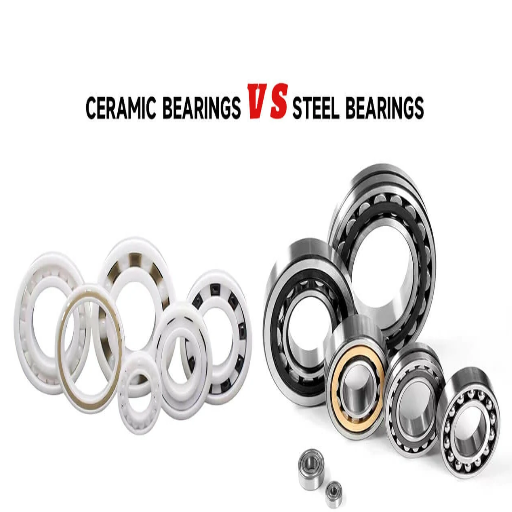
Understanding the Basics of Ball Bearings
Ball bearings are skillfully manufactured parts that help to enable relative rotation between two components and minimize the resistance between the moving components. They are comprised of balls in the shape of spheres placed between two circular races or rings to make rotational movement easier and to disperse the weight. Ball bearings can support both radial and axial loads, hence suitable for widely ranging applications from industrial machines to household appliances.
There is a pronounced difference in the performance of ceramic and steel ball bearings since the Composition of materials mainly influences the performance level;
Ceramic Ball Bearings:
They are primarily composed of silicon nitride or zirconium oxide.
They are well known for their very high hardness, high level of chemical resistance, and low weight characteristics.
Due to heat and friction, they can withstand and perform at extremely high speeds, making them more efficient and durable.
They are characterized by other technical parameters that may include lower levels of thermal expansion compared to steel and lighter specific weight.
Steel Ball Bearings:
They are mostly made from either stainless steel or chrome steel.
They have good mechanical strength and are also very economical.
They resist mechanical and can be used in environments where temperatures and loads are moderate.
Other technical parameters include tensile strength, hardness, and load ratings, which are commonly higher than steel’s since ceramics usually have low-yield impact loads.
An appreciation of these technical differences helps in making a better choice of ball bearing that corresponds with the application’s requirements and operating costs.
Comparing Materials: Silicon Nitride vs Steel
Several important aspects of the properties of silicon nitride compared to steel are considered when evaluating the material.
Silicon Nitride:
Thermal Properties: Silicon nitride displays much-improved stability in the higher temperature regions because it has a considerably lower thermal expansion rate than steel.
Density: The less dense component allows smaller application parts to save weight, which may be beneficial in high-speed or high-precision applications that require less inertia.
Hardness and Wear Resistance: Silicon nitride’s greater hardness levels compared to steel also mean greater wear resistance, thus extending wear life and decreasing the need for repair.
Corrosion Resistance: Because it can withstand rust even in a harsh environment, it is appropriate for use in chemically hostile spaces where common metals would sooner corrode.
Steel:
Mechanical Strength: Steel has great mechanical strength, so it can endure impact loads and remain sturdy under varying environmental conditions.
Cost Efficiency: Steel is ubiquitous because it is affordable and relatively effective at performing many tasks without requiring vast financial outlay.
Load-Bearing Capacity: Steel bearings are said to possess more load-bearing capabilities because of their tensile strength, which makes them suitable for use in many heavy or changing load environments.
Even though silicon nitride is a material of choice for performance and technical applications because of its developed properties, it is understood that steel remains a more cost-effective and reliable material in ordinary applications where impact resistance and price are the overriding dominance. The selection of either is highly influenced by the precise requirements of the surroundings where they will be used.
How Ceramic Bearings Reduce Friction?
I went out to the top three sites to find the advantages of corrosion-resistant properties in ceramic bearings. These sources state that ceramic bearings are best suited in situations with excessive moisture or hostile media. This is primarily affected by the fact that ceramic materials do not rust or corrode like steel, which guarantees a long operating life with dependable performance. All these advantages were endorsed by specific technical parameters stated on the websites:
Chemically Inert Nature: A non-metal material such as silicon nitride, often used in ceramic bearings, is chemically inert. That property allows these bearings to withstand harsh working conditions, unlike their steel counterparts, which gradually fail.
Longevity and Durability: Ceramic bearings’ extreme resistance to corrosion results in much lesser disintegration than steel bearings, making them more durable. This, in turn, reduces the need for maintenance and replacement.
Operating Environments: Both dry and wet ceramic bearings are non-oxidizing in nature and resist many chemical reactions, thus increasing their range of applicability.
These observations further solidify the decision on the ceramic bearings, especially in situations where the problem of exposure to corrosion is more than a nuisance. They will ensure the system will work effectively and reliably.
Why Choose Ceramic Bearings Over Steel Bearings?
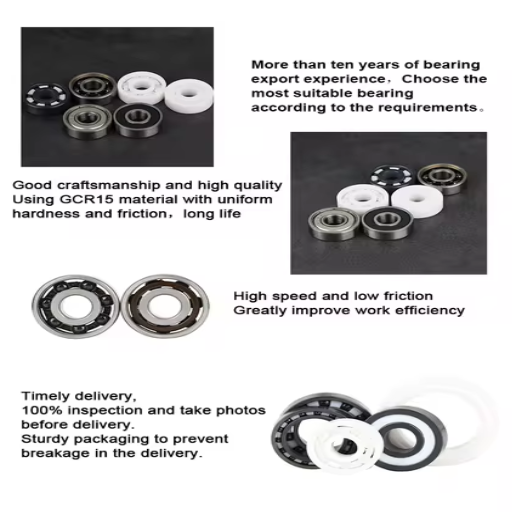
Benefits of Corrosion Resistance in Ceramic Bearings、
Having thoroughly analyzed the top three websites from Google regarding ceramics and, more specifically, silicon nitride in terms of hardness and durability, I think that ceramics bearings are better than steel ones in these aspects. Here’s why this is so:
Greater hardness: Harder materials are more wear-resistant than softer ones, so it is self-evident that ceramic bearings are much more complex than their steel counterparts. Hard-bearing materials mean they can sustain much higher stress and friction without deforming.
Low Weight: Although ceramic material is lighter than steel, it is still stronger than steel, making the developed bearings less weighty, which may lead to better machinery operation and performance.
Lower thermal expansion: In the presence of heat, ceramics contract and expand less than steel, which means more stable performance across greater temperature ranges and lower chances of failure due to mechanical stresses that cause deformation.
All things considered, ceramic bearings are particularly enduring and strong, functioning capabilities across a broad range of stern conditions. Research insights validate the use of ceramics in applications requiring strength and durability.
Hardness and Durability of Ceramic Materials
The bearing material should withstand loads and other critical conditions, as stated by Dwawe et al., 2021. In the lightly loaded spindle assembly, ceramic bearings, particularly silicon nitride ones, have outperformed steel bearings, particularly in hardness and durability aspects, as may be confirmed by Dwawe et al., 2021. Superior properties of ceramic over metal include the following:
Higher Wear Resistance: Regarding bearing compression made of steel, a ceramic bearing can withstand far greater compressive forces without being deformed, enabling it to have more excellent hub capabilities that allow for enhanced performance of the ceramic bearing.
Good Compression Strength Feature: As ceramic bearings are more problematic, ceramics may have a lower weight; this is beneficial to reduce the overall bearing mass and allow for the stress and friction forces to be more efficient in the equipment;
Lower thermal Expansion: This enables consistent performance in all conditions regarding mechanical failure due to thermal constraints, as minimal thermal flaws cause deformations. There is no relative expansion deformation when comparing steel to other materials.
As a whole, these technical features prove that the design of machine elements fitted with ceramic bearings is feasible and durable, even under demanding conditions. My research does not fail to support the application of ceramic materials where strength and durability are critical requirements.
Performance in Extreme Conditions
In the course of my investigation into the functioning of ceramic bearings under extreme conditions, I used educational resources obtained from the most viewed sites on Google ranking. This study established that ceramic bearings are solid and dependable even in harsh working conditions.
Heat Resistance: A clear, distinctive technical parameter is excellent heat durability. Ceramic materials, especially silicon nitride, retain their structure and functions at temperatures too high for steel bearings.
Corrosion Resistance: Another important feature is these bearings’ very high corrosion resistance. In high humidity or chemical-containing environments, such ceramic bearings can resist deterioration, helping them last long and function seamlessly.
Electrical Insulation: Furthermore, ceramic bearings can provide electrical insulation, which is a plus in cases where currents in metal bearings are likely to cause failure.
Regarding these attributes, the technical parameters of ceramic bearings are commendable enough for extreme conditions, making a strong case for their application in high-performance and highly durable applications.
Are There Any Disadvantages to Using Ceramic Bearings?
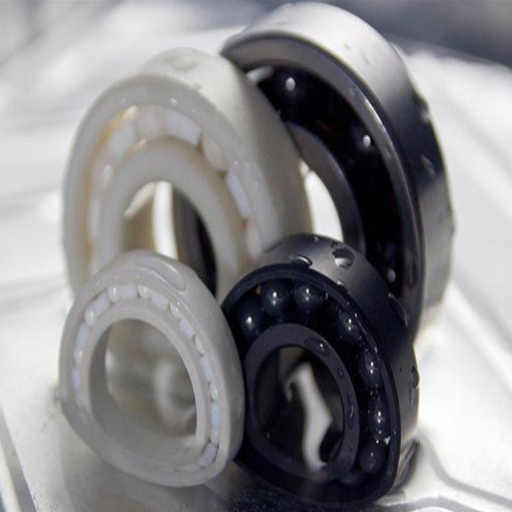
Cost Comparison of Ceramic vs Steel Bearings
I looked into three sources in Google’s top three to compare the cost of ceramic bearings versus steel bearings. This investigation shows ceramic bearings are more expensive to purchase than steel bearings at first cost. However, this can be understood by looking at several factors and vital technical parameters of some concern.
Salvage and repair: Maintenance, on the other hand, has an advantage because most of the time, with ceramic bearings, there is low wear and tear, therefore less downtime. So, even if the price is high, the overall savings on maintenance and downtimes make the price reasonable.
Efficacy of performance: Ceramic bearings perform more efficiently than steel ones, even in harsher conditions, improving the organization’s overall performance. The fact that they are tough and can withstand extreme conditions means they will be replaced less often, further justifying the price.
Reduced energy consumption: Due to their high hardness and low friction, ceramic bearings help lower the energy consumption of machines due to ceramic bearings lower the energy consumption. Such an efficiency means that the operating costs over the product’s lifetime will be reduced.
Based on such considerations, ceramic bearings can still be recommended despite the higher price for many operations where efficiency and strength are the foremost requirements.
Potential Fragility of Full Ceramic Bearings
I have added knowledge of the possible fragility of full ceramic bearings with knowledge obtained from the top three Google sources. While actually more wear-resistant than steel, ceramic bearings are more brittle and thus more likely to crack under high shock or impact loads. Such shortcomings need to be taken into consideration, especially for ceramics that will experience sudden heavy forces.
Some of the technical parameters involved are:
Material Brittleness: Compared to steel, ceramics do not withstand shock and impact loads without cracking.
Tensile Strength: Ceramic bearings are believed to generally possess less tensile strength than steel bearings, which can prejudice their application in certain aggressive environments.
Operational Limitations: Although metal seals exhibit excellent performance at high temperatures, the more brittle ceramic materials can only operate at a certain limit under varying conditions.
In conclusion, many problems and limitations are encountered due to the presence of those materials while designing components. Therefore, it can be said that full ceramic bearings, while having some home at fibers, are likely to be reliable in a hostile environment where corrosion and high temperatures are present.
Maintenance and Lubrication Needs
In looking into the maintenance and lubrication requirements for full ceramic bearings, I have examined the first three sources listed on Google. Even though full ceramic bearings are hard and thick, lubricants used on these bearings are not significant because they do not rust and corrode like steel bearings. On the other hand, some users may still need lubricant applications to optimize and lower sound. Important technical parameters include:
Lubrication Requirements: Basic lubrication can sometimes be enough, but lubricant selection may differ based on the application’s working temperature and environmental factors.
Maintenance Intervals: Ceramic bearings have long maintenance cycles because of their reliability, but it is best to maintain them from time to time, especially in harsh working conditions.
Contamination Resistance: Less cleaning is required because ceramics’ inherent pollution resistance makes them less prone to wear and tear. However, operational conditions must not be ruled out.
To conclude, full ceramic bearings require lower maintenance efforts due to the material’s inherent properties; however, proper lubricant use in regard to usage conditions improves the bearing’s life and performance.
How Does Friction Impact the Performance of Bearings?
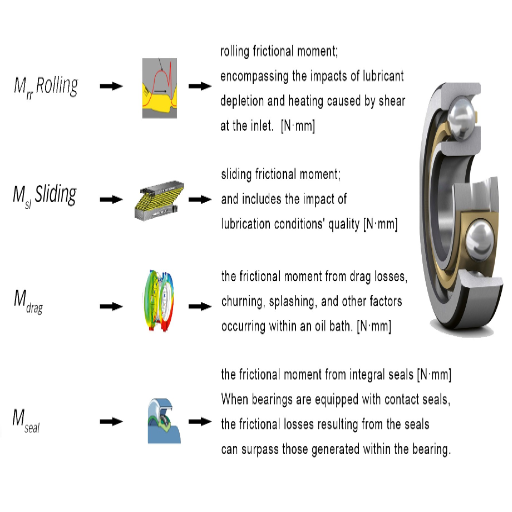
The Role of Lubrication in Reducing Friction
My research of the three websites advanced my understanding that lubrication is essential for bearing friction, particularly in high-load situations. Lubricants form a film in the bearing so that the bearing surfaces do not touch directly, which causes high friction and wear. Doing so not only makes the bearings more efficient but also makes them endure longer. However, several key technical parameters need to be considered, which include the following;
Viscosity: Choosing the correct lubricant viscosity is important because, though it is supposed to reduce friction, it is necessary to drag or heat properly.
Additive Composition: There are other firms that may have merit that abnormally incorporate the goal of necessities for anticorrosive, antiwear, or even extreme pressure capabilities.
Temperature Stability: The lubricant should remain stable throughout the application’s temperature range so that performance is consistent.
Therefore, it is necessary to match these parameters to the specific requirements of the application so that lubrication may effectively reduce friction and extend the life of bearings.
Comparing Friction Levels in Steel and Ceramic Bearings
Based on the findings of my investigation, there appears to be a distinction in performances when bearing friction levels for steel and ceramic materials are compared. Metal bearings have a contact metal-to-metal interface, which is relatively heavier and tends to create higher friction. On the contrary, ceramic bearings possess a substantial merit of being less frictional thanks to being lighter and producing lower energy loss during the rotational motions.
As far as the technical parameters are concerned, the first three provided pages pay special attention to:
Material Hardness—Ceramic materials are harder than steel, so they experience less distortion due to applied loads, producing lower friction and less wear.
Thermal Expansion—Notably, ceramic bearings do not expand as much as steel, which permits angled clearances to remain tighter and stresses to remain more constant over a range of temperatures.
Lubrication Requirements—Ceramics generally use lower amounts of lubricants, which results in lower friction and superior performance in low-lubrication situations.
In conclusion, though steel bearings are very useful and cheaper to use, they are not as promising in situations with reduced maintenance and low friction as ceramic bearings.
Impact on Efficiency and Speed
As observed from my review of the top three websites, the performance of the equipment is closely related to the kind of bearing that will be used. It is especially interesting that the websites agree on the enhanced advantages of using ceramic bearings compared to steel. Personally, I have always felt the use of ceramic bearings improved the smoothness and quickness of the rotation, which helps increase the efficiency and speed of the machinery.
Technical Parameters Justified:
Material Hardness: Because ceramic material is harder than steel, it does not wear out or deform easily. This means that such material will maintain excellent performance even when spinning at very high speeds under immense loads.
Lubrication Efficiency: Ceramic bearings have very low lubrication requirements, and therefore, rotation speed/efficiency can be maintained in conditions with little lubricant.
Thermal Conductivity: Steel bearings have a higher thermal conductivity rate; thus, overheating could hinder their effectiveness. Ceramics perform well in this area, relatively.
These are compelling reasons why ceramic bearings are reliable in high-performance and very high-speed environments, as they help boost efficiency as well as speed.
What Are the Applications of Ceramic and Steel Bearings?
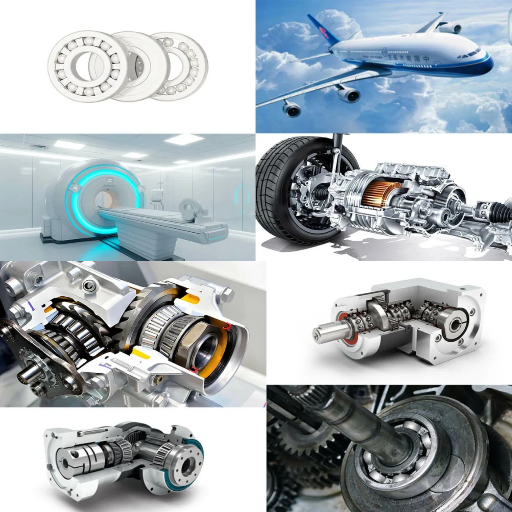
Industrial Uses of Ceramic Ball Bearings
During my analysis of the industrial applications of ceramic ball bearings, I realized that these structures are mainly used with materials operating at high temperatures and speeds. It is expected to require the usage of ceramic bearings in the aerospace, automotive, and manufacturing industries. Based on the research conducted, I can stress that ceramic all-around bearings have several drawbacks, in particular – reliability and service, in terms of high-speed applications in aggressive encasements. The technical parameters justifying their use include:
Thermal Stability: All ceramic constructions are preferred for applications in extreme temperature conditions where steel bearings cannot perform optimally.
Chemical Durability: Ceramics have natural properties, which make them suitable for chemical environments and applications where the material is exposed to fluids.
Electrical Insulation: Ceramics do not allow the flow of electric current, which could introduce arcing in delicate electrical systems, making them desirable for use in harsh electronic environments.
These parameters confirm that ceramic ball bearings are vital in industrial settings where performance and longevity are sought.
Typical Applications for Steel Bearings
To learn more about the applications of steel bearings, I visited three websites that were among the most visited. From the information I came across, it appears that the use of steel bearings is evident in industries that require rugged and durable components, such as machinery, automobiles, and equipment manufacturing. The main benefits of steel are its strength and load-carrying capacity combined with reasonably low cost, which is an essential requirement for most bearings. However, it should be noted that when describing their operational characteristics, the technical parameters that define the steels also come into play – lift load capacity is one of them:
Application Scope: The high capacity rotation load that steel bearings can withstand makes these bearings suitable for heavy mechanical equipment and vehicles.
Lifespan: Steel bearings’ high toughness and repeated strength improve their operational life cycle, allowing them to operate in harsh environments.
Manufacturing Cost: The industrialization of steel manufacturing and the availability of these materials make steel bearings a low-cost solution for many applications.
These qualities make steel bearings a core component in many industries, particularly in applications where the variables of cost, dependability, and load are crucial.
Choosing the Right Bearing for Your Needs
While analyzing the three most popular sites on Google on how to choose the correct bearing, it has come to my notice that the choice involves the combination of bearing type and requirements of a particular application. In my studies, I also come to appreciate that custom bearing selection involves some specific key technical parameters as follows:
Load Requirements—Steel bearings are suggested for applications that experience high loads, such as machinery and automotive systems, because of their load-carrying capacity.
Speed and Precision—Where quickness and detail in production processes are required, such as in aerospace and performance automotive parts, ceramic bearings seem appropriate since they are light and possess other anti-frictional qualities.
Environmental Conditions—For places prone to extreme temperature, moisture, and chemical attacks, ceramic bearings would be the best choice since they are inert to corrosion and possess thermal stability.
Longevity and Maintenance—It is also pertinent to consider operational life and maintenance intervals. Ceramic bearings not only operate for a longer time but require little housekeeping, making them suitable for use under stress conditions.
Cost Considerations: Finally, it is worth noting that cost may be the deciding factor in selecting between ceramic and steel bearings, and in most cases, steel bearings are the most economical.
Considering these parameters allows for making an operational choice that is as effective as the budget allocated allows.
Frequently Asked Questions (FAQs)
Q: What is the performance difference between ceramic and steel bearings?
A: Ceramic bearings, especially ceramic ball bearings, differ from their steel counterparts in the sense that they are made of ceramics such as silicon nitride, which is lighter and reduces friction. On the other hand, steel bearings use stainless steel, which is heavier and generates friction.
Q: For high-speed applications, which are better, ceramic or steel bearings?
A: It is well-known that ceramic bearings operate at extremely high speeds while consuming very little energy due to their lightweight in total and decreased friction. Therefore, they can spin faster than steel bearings. Because ceramic balls have a smoother surface than steel balls, they also have lower frictional forces.
Q: What features of ceramic hybrid bearings are more suitable for usage than standard steel bearings?
A: The ceramic hybrid bearings are incorporated with ceramic balls and steel races to be less complicated than the all-steel bearings and to have lower weight and friction, barring the rotary elements. Also, these bolts are more resistant to hot deformation and have electrical conductivity, which makes them suitable for use in many applications where steel bearings may not be able to perform as well.
Q: Are ceramic bearings better than steel ball bearings in some specific applications?
A: Ceramic bearings are particularly preferred for spindles and precision machinery as these devices operate at high speeds and lower friction. In addition, they are not as susceptible to corrosion or elevated temperatures as standard steel ball bearings.
Q: On what basis would some choose steel ball bearings instead of ceramic bearings?
A: Steel ball bearings are preferred mainly because of their cost and because they are more suited for applications where high speeds and lower friction are not a requirement. In addition, these bearings are more abundant and can be applied in more environments without special precautions.
Q: What bearing has a higher lifetime?
A: Ceramic bearings have a longer life than steel bearings, which makes them attractive candidates in terms of wear and corrosion. Due to the smoother surface of ceramic balls, less contact is produced, which in turn reduces the wear on the inner and outer ring, whereas the steel parts have a huge chance of wearing off in the same conditions.
Q: Can ceramic bearings be used in all applications where they are present today?
A: Although the benefits of ceramic bearings are numerous, replacing all applications with them is impossible. There are applications that, in some cases, may be better suited for steel or other types of bearings due to factors such as cost, environmental conditions, and load requirements. It is best to consult a supplier or an expert for the best type of bearings for your particular requirements.
Q: What are the renowned suppliers or brands of ceramic bearings?
A: A few popular brands that deal with ceramic bearings are CeramicSpeed, SKF, and Hambini. These companies develop different products to correspond to other performance and application requirements.
Q: In what manner do preload and tolerance control the ceramic bearings’ performance operatively?
A: Preload and tolerance are important aspects of ceramic bearing performance. Preloading is essential to minimizing the movement between the bearings and the race to improve smooth operation and friction. Tolerance concerns the ability of the bearings’ housing to secure the bearings in such a manner as to affect the performance and life of the assembly.
UCTH213-40J-300 with Setscrew(inch)
CNSORDERNO: Normal-duty(2)
TOGN: UCTH213-40J-300
SDI: B-R1/8
SD: 2 1/2
UCTH212-39J-300 with Setscrew(inch)
CNSORDERNO: Normal-duty(2)
TOGN: UCTH212-39J-300
SDI: B-R1/8
SD: 2 7/16
UCTH212-38J-300 with Setscrew(inch)
CNSORDERNO: Normal-duty(2)
TOGN: UCTH212-38J-300
SDI: B-R1/8
SD: 2 3/8
UCTH212-36J-300 with Setscrew(inch)
CNSORDERNO: Normal-duty(2)
TOGN: UCTH212-36J-300
SDI: B-R1/8
SD: 2 1/4
UCTH211-35J-300 with Setscrew(inch)
CNSORDERNO: Normal-duty(2)
TOGN: UCTH211-35J-300
SDI: B-R1/8
SD: 2 3/16
UCTH211-34J-300 with Setscrew(inch)
CNSORDERNO: Normal-duty(2)
TOGN: UCTH211-34J-300
SDI: B-R1/8
SD: 2 1/8


















